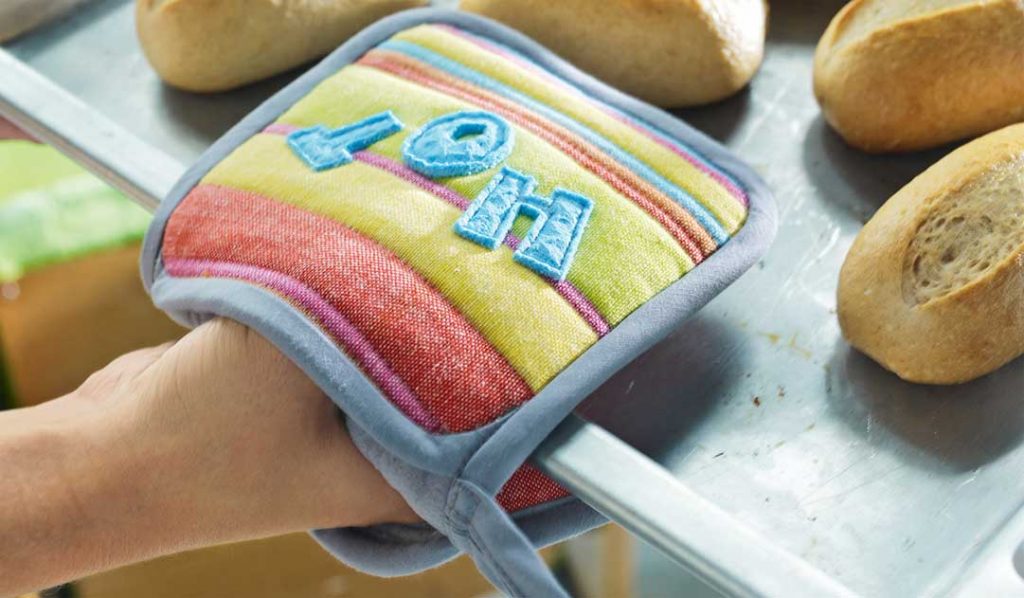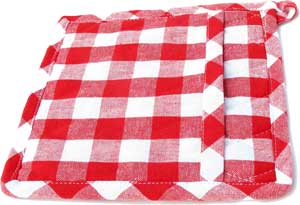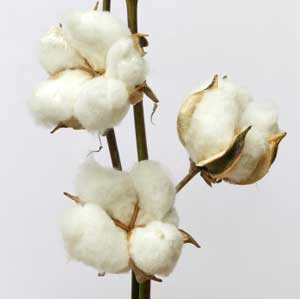Do you know how to use a wing needle? This 1 minute video gives you a sneak peak on using this specialty needle
Using a Wing Needle
Do you know how to use a wing needle? This 1 minute video gives you a sneak peak on using this specialty needle
Whether you call them hot pads or potholders, the purpose is the same—to protect hands and table surfaces from the heat of a pan just removed from the stove or oven.
Hot pads are an ideal beginner sewing project (perfect for kids), and they’re a fun way to use up scraps since they don’t take much fabric. Because of their size, they’re also ideal to experiment with new sewing techniques you may want to try out before using on a larger project.

Hot pads can be made in many sizes and shapes, but one thing’s for certain, whatever shape you choose, be sure they’re large enough to keep your hands from getting burned when in use.
Many potholders are simple squares—from 5” to 10”, though the larger sizes offer better protection. Some are circular and of similar sizes, while others are rectangular and designed to be folded over a warm pot handle. There are also patterns for holiday themed shapes, like Easter eggs, Valentine hearts or Christmas trees.
In addition to their padded selves, most potholders offer an extended loop for hanging. The loop can be made of the same fabric as the holder or from the binding used around the shape’s edge. Loops can be along one side, or at a corner.
The anatomy of a potholder is simple—two layers of fabric with heat-resistant protective layers between. It’s important that the outer fabric layers are not synthetic, as they should be able to withstand heat up to 400° Fahrenheit. Cotton is a good choice for the outer layers as it’s heat resistant and readily washable.
Between the outer layers is the main source of heat protection. Some sewers like to use multiple layers of preshrunk wool for its insulative qualities, others use layers of cotton batting, and perhaps most effective is a batting with an insulative layer, like Insul-Bright®, made by the Warm Company or Pellon Insul-Fleece™. (Product links lead to Amazon and any purchases you make may make us a small commission at no additional cost to you). This specialized product has a metallicized polyester film needle-punched into batting. This heat-protective layer should then be sandwiched between two layers of cotton batting.
Because of their small size, potholders are the perfect canvas to try a new sewing technique like appliqué, machine embroidery or decorative stitching (with cotton threads), strip piecing, scrappy piecing, etc.
Simply draw the shape of your potholder onto the right side of one fabric layer, do your embellishing and trim the piece to size. If you’re piecing the potholder front and/or back, do that sewing before cutting the shapes.
To make a hot pad, layer the back and front pieces wrong sides together with your choice of the inside insulative layer(s). Pin the layers and quilt them together. Quilting can be done in straight lines, free-motion designs, or using an embroidery machine. If you choose not to quilt the layers together, baste around the perimeter about 1/8” from the cut edges.
Cut a 2 ¼”-wide strip of binding fabric to go around the potholder. Depending on the size, it may be necessary to piece together two width-of-fabric strips. Note: If your potholder has curved corners, cut the binding on the bias. Fold the binding in half wrong sides together and press.
 Bind the potholder, mitering the binding at any corners. When you come back to the starting point, stop just before the original stitching, but do not trim of the extra binding length.
Bind the potholder, mitering the binding at any corners. When you come back to the starting point, stop just before the original stitching, but do not trim of the extra binding length.
Turn the binding to the underside and hand- or machine-stitch the folded edge in place. At the original start point, fold the binding and extend it to form a hanging loop and stitch the edges together, tucking the raw end under the end of the binding portion. Finish the stitching to anchor the loop base.
Once you’ve mastered the basics of potholder making, consider adding a pocket to one side. Slide your hand inside for easier gripping with the padded portion of the hot pad.
~Linda Griepentrog
Linda is the owner of G Wiz Creative Services and she does writing, editing and designing for companies in the sewing, crafting and quilting industries. In addition, she escorts fabric shopping tours to Hong Kong. She lives at the Oregon Coast with her husband Keith, and two dogs, Yohnuh and Abby. Contact her at .
Enjoy our 40 minute chat with Sarah McFarland of Threads Magazine. Shara shares her journey to her role as Editorial Director, as well as the incredible opportunity she has to mingle with some of the greatest talents the sewing world has to offer.
~Sheryl Belson
This is article 1 of a multi-part series focusing on three categories of fabric – fabric made from plants, from living things, and from minerals. This month – plants!
Plants (part 1) | Plants (part 2)
Living Things: Silk | Living Things: Wool | Other Living Things
Minerals: Acrylics, Polyester, & Nylon (part 1) | Minerals: Spandex and Rayon (part 2)
Did you know that the overall global textile industry is valued at nearly one trillion dollars? The plant-sourced portion of this market grows about 7% annually and now makes up about 1/3 of the total fabric market. It also can have an ecologically positive impact on our planet.
Processing leaves, stems, stalks, seed pods, and fruit into fabric is BIG business!
While some are common and have been around for ages (think cotton and flax), other fabrics made from plants are gaining popularity. With an increased demand for fabric that is cruelty free, as well as the environmental concerns associated with creating synthetic fibers, shoppers are turning to some of the oldest and most sustainable plant fibers.
If you answered ALL of them, you would be correct!
You will certainly recognize some of the plant sources such as cotton, flax (used in linen production) bamboo, and cork. But a few may surprise you. In Part 1, we are covering Cotton and Flax and have also included links to info on Bamboo and Cork.
 Cotton is the natural textile fiber most widely used around the world. It takes center stage in the global textile industry, capturing about 25% of the market. And it is not a newcomer! Cotton was grown in Pakistan’s Indus Valley more than 5,000 years ago and was used to make clothing in ancient Egypt. Cotton is widely used in the modern fashion industry, both in flat fabrics and in woven clothing items and household textile products and it combines well with other natural and synthetic fibers, such as rayon, polyester, spandex, etc. Let’s face it… cotton is a fabric staple that is here to stay.
Cotton is the natural textile fiber most widely used around the world. It takes center stage in the global textile industry, capturing about 25% of the market. And it is not a newcomer! Cotton was grown in Pakistan’s Indus Valley more than 5,000 years ago and was used to make clothing in ancient Egypt. Cotton is widely used in the modern fashion industry, both in flat fabrics and in woven clothing items and household textile products and it combines well with other natural and synthetic fibers, such as rayon, polyester, spandex, etc. Let’s face it… cotton is a fabric staple that is here to stay.
How is it processed?
Cotton comes from plants that produce seed pods filled with ball-shaped clumps of cotton fiber. The seeds are separated from the cotton fiber mechanically and then the threads are spun from the remaining, seedless white fiber. The resulting threads are then woven to make cloth, which can be dyed. To watch and learn more about the process, view this 6-minute video.
What about sustainability and the environmental impact?
The biggest bet of sustainability is the use of certified organic cotton. Organic cotton is more eco-friendly than non-organic cotton, as it uses less water and is free of chemical pesticides, insecticides and herbicides that may otherwise pollute waterways.
Where can you buy it?
You can buy cotton and cotton blends almost anywhere. This is one fabric you will not have any trouble finding. But to give you a few places to purchase with your ASG Member discount, check out these sellers:
Linen is another popular and common fabric, though it captures a much smaller market share than cotton. It is made from the fibers of the flax plant and is considered more of a luxury fabric than cotton. Egyptians used flax to create linen cloth more than 4,000 years ago and used it in both clothing and to wrap mummies. Today, flax is often blended with other materials to add strength or reduce wrinkles.
How is it processed?
Flax has leaves that consist of long, tough fibers. The procedure to turn the plants into fabric is labor intensive, which makes linen much more expensive than cotton. To get a peek into the process, watch this 2 ½ minute video from the V&A museum.
What about sustainability and the environmental impact?
Flax is one of the more promising developments in sustainable textiles since it can be grown with far less water and fewer pesticides than cotton and produced at a lower price.
Where can you buy it?
Like cotton, you can buy linen and linen blends many places. Buy it with your ASG Member discount from one of these sellers:
In Part 2 of Fabric Sources: Plants, we’ll cover some of the unusual and unexpected plants that are used to create fabric.
~Sheryl Belson
Ever wondered how to line-up/match the pattern of your fabric across seams? This 1-minute tutorial is a sure fire way to get it right!
American Sewing Guild
National Headquarters
9660 Hillcroft, Suite 230
Houston TX 77096
713-729-3000 | 713-721-9230 Fax
www.ASG.org
